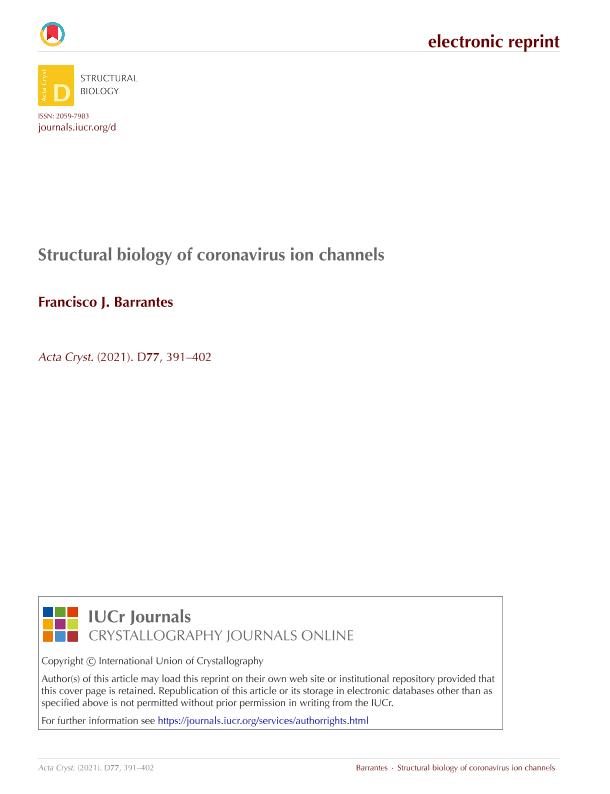Mostrar el registro sencillo del ítem
dc.contributor.author
Barrantes, Francisco Jose

dc.date.available
2021-07-02T13:19:45Z
dc.date.issued
2021-04
dc.identifier.citation
Barrantes, Francisco Jose; Structural biology of coronavirus ion channels; International Union of Crystallography; Acta Crystallographica Section D: Structural Biology; 77; 4-2021; 391-402
dc.identifier.issn
2059-7983
dc.identifier.uri
http://hdl.handle.net/11336/135373
dc.description.abstract
Viral infection compromises specific organelles of the cell and readdresses its functional resources to satisfy the needs of the invading body. Around 70% of the coronavirus positive-sense single-stranded RNA encodes proteins involved in replication, and these viruses essentially take over the biosynthetic and transport mechanisms to ensure the efficient replication of their genome and trafficking of their virions. Some coronaviruses encode genes for ion-channel proteins - the envelope protein E (orf4a), orf3a and orf8 - which they successfully employ to take control of the endoplasmic reticulum-Golgi complex intermediate compartment or ERGIC. The E protein, which is one of the four structural proteins of SARS-CoV-2 and other coronaviruses, assembles its transmembrane protomers into homopentameric channels with mild cationic selectivity. Orf3a forms homodimers and homotetramers. Both carry a PDZ-binding domain, lending them the versatility to interact with more than 400 target proteins in infected host cells. Orf8 is a very short 29-amino-acid single-passage transmembrane peptide that forms cation-selective channels when assembled in lipid bilayers. This review addresses the contribution of biophysical and structural biology approaches that unravel different facets of coronavirus ion channels, their effects on the cellular machinery of infected cells and some structure-functional correlations with ion channels of higher organisms.
dc.format
application/pdf
dc.language.iso
eng
dc.publisher
International Union of Crystallography
dc.rights
info:eu-repo/semantics/openAccess
dc.rights.uri
https://creativecommons.org/licenses/by-nc-sa/2.5/ar/
dc.subject
CORONAVIRUSES
dc.subject
COVID-19
dc.subject
CRYO-ELECTRON MICROSCOPY
dc.subject
SARS-COV-2
dc.subject
STRUCTURE-FUNCTION CORRELATIONS
dc.subject
VIRAL ION CHANNELS
dc.subject
VIROPORINS
dc.subject.classification
Biofísica

dc.subject.classification
Ciencias Biológicas

dc.subject.classification
CIENCIAS NATURALES Y EXACTAS

dc.title
Structural biology of coronavirus ion channels
dc.type
info:eu-repo/semantics/article
dc.type
info:ar-repo/semantics/artículo
dc.type
info:eu-repo/semantics/publishedVersion
dc.date.updated
2021-07-02T12:51:27Z
dc.journal.volume
77
dc.journal.pagination
391-402
dc.journal.pais
Reino Unido

dc.journal.ciudad
Chester
dc.description.fil
Fil: Barrantes, Francisco Jose. Pontificia Universidad Católica Argentina "Santa María de los Buenos Aires". Instituto de Investigaciones Biomédicas. Consejo Nacional de Investigaciones Científicas y Técnicas. Oficina de Coordinación Administrativa Houssay. Instituto de Investigaciones Biomédicas; Argentina
dc.journal.title
Acta Crystallographica Section D: Structural Biology
dc.relation.alternativeid
info:eu-repo/semantics/altIdentifier/doi/http://dx.doi.org/10.1107/S2059798321001431
Archivos asociados
